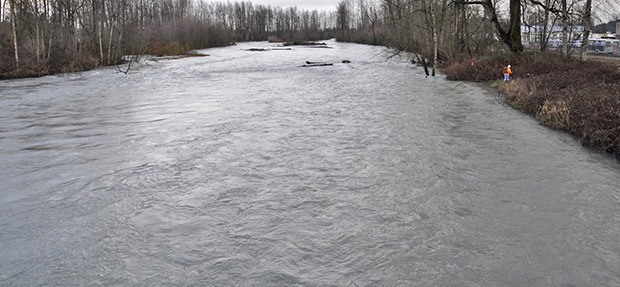King County officials have announced plans for voluntary acquisitions of seven houses in Pacific’s flood-prone White River Estates neighborhood.
That was among the immediate and long-term remedies public officials from several jurisdictions offered during a two-hour special meeting Feb. 18 at the Pacific Community Center Gym.
Two days earlier, the King County Flood Control District Board of Supervisors had offered $3 million to acquire those homes and enhance containment with an expanded HESCO barrier line to protect houses and property.
This marks the second time King County officials have approved the purchasing of flood-soaked properties in White River Estates. Pacific Mayor Leanne Guier said the county also bought a dozen properties after the White River spilled floodwaters over its banks in January 2009 and damaged more than 110 homes and 10 businesses, leaving $15 million in losses in its wake. One-fifth of the city’s 6,000 residents were displaced at the time.
Guier said the seven properties along White River Drive abut the houses the county bought in 2009-10 and later removed. She said King County officials would offer “fair market value” for the seven properties, which were selected because they are the most flood-plagued in the community.
Along with those developments, King County supervising engineer Jeanne Stypula said she expects work on the Lower White River Countyline Levee Setback Project to begin in May and finish in December 2017. That project, which is budgeted at $19 million, would construct a new, 6,000-lineal-foot setback levee along the landward edge of a forested buffer to protect existing properties and structures. A 5,780-lineal-foot, bio-engineered bank revetment also would be constructed along the existing wetland edge for the same purposes.
Stypula said a forested riparian buffer, of about 17 acres, would be restored adjacent to the wetland, too. That work, along with removal of the approximately 4,100-lineal-foot current levee and bank armoring, would reconnect the river with 121 acres of off-channel aquatic habitat for the first time in almost a century and reduce flood elevations in Pacific.
The Lower White River Right Bank Levee Setback Project is in the development stage, according to Stypula. That project, which she estimated will cost $25-30 million, would remove interim flood protection measures, such as the HESCO wall, and construct a setback levee along the Pacific Park boundary and adjacent residential areas on the right bank. Stypula said that project would significantly reduce the potential for flooding in those areas.
But some White River Estates residents expressed frustration that those projects have not been completed.
City councilman David Storaasli said, based on the original timelines released by King County officials, that the Lower White River Countyline Levee Setback already should be finished.
“We’re not going to believe that you’re going to start until you start,” he said.
Stypula acknowledged that both projects are behind schedule, but she said that was done with an eye toward designing a sustainable solution.
“We believe these levees will last without overtopping for 50 to 70 years when we’re accounting for sediment,” she said.
Ken Brettmann, senior water manager for the Army Corps of Engineers’ Seattle District, said those enhancements are significant because “the White River is losing channel capacity at a rapid rate.” He said in-stream flow was 20,000 cubic feet per second in 1948 compared to about one-quarter of that rate now.
He said that is problematic because the Mud Mountain Dam’s reservoir, which is 5 1/2 miles long and can store 106,000 acre feet of water, can fill rapidly. Brettmann said the flood-control facility, which was constructed in 1948, was 40 percent full Feb. 18 after “moderate” rain in the preceding days. Water from the dam flows into the White River and ultimately the Puyallup River. The dam’s primary purpose, Brettmann said, is to protect the area along the lower Puyallup because more infrastructure and property are at risk there than along the White River.
“We have to accept some impacts to avoid catastrophic flooding,” he said. “Mismanaging this reservoir increases everyone’s flood risks.”
With those challenges in mind, some residents questioned whether officials should remove sediment, which Brettmann said was the main reason behind the White River’s lagging in-stream flow, through dredging or gravel bar “scalping” to give it more room within the floodplain.
But Tony Fantello, who oversees Pierce County’s levees, said that remedy is “short-lived,” expensive and could present problems under the Endangered Species Act related to the river’s salmon population.
Multiple officials said “flood season” runs through April and recommend that residents take precautions, such as signing up for flood alerts. Stypula said that can be accomplished at green2.kingcounty.gov/floodalertsystem/ to find out about flood warnings, which are listed in four different classifications, via email, phone call or text.



